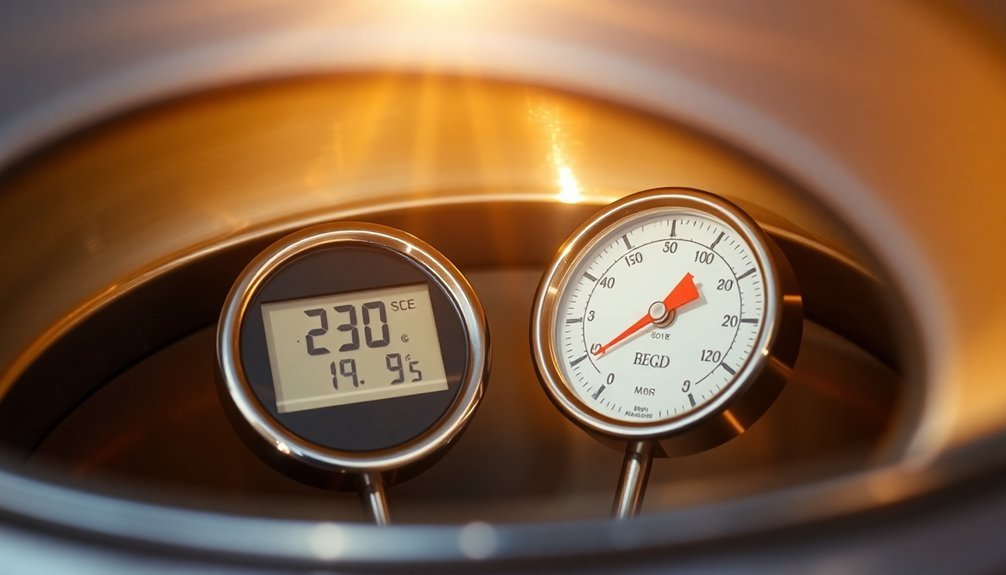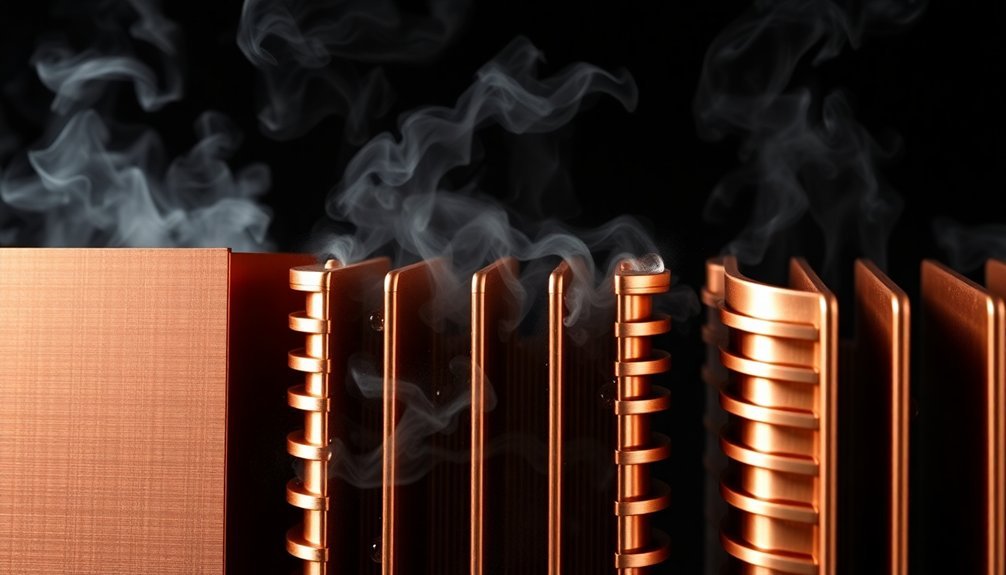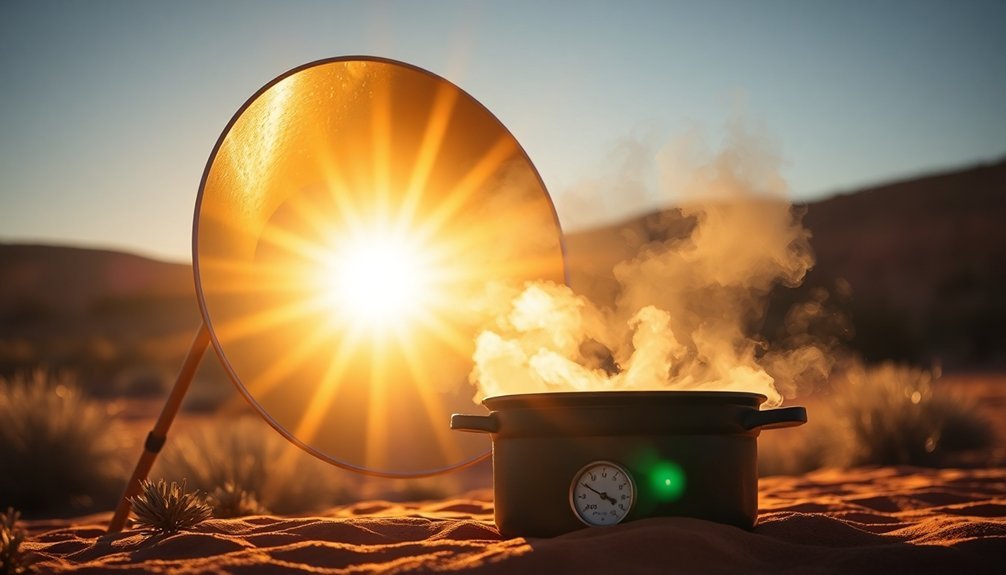You'll track your sun oven's temperature effectively using three reliable methods. Digital temperature monitoring apps offer real-time data and customizable alerts right on your smartphone, helping you maintain precise cooking temperatures. Manual thermocouple methods, using calibrated probe thermometers, provide accurate readings directly from your oven's cooking chamber. Solar position tracking devices guarantee ideal sun exposure, which directly impacts temperature maintenance throughout the cooking process. Understanding these tracking methods and implementing them correctly can release the full potential of your solar cooking experience.
Digital Temperature Monitoring Apps
How does modern technology make solar cooking more precise? Digital temperature monitoring apps like GoSun and CookSolar now give you real-time data to perfect your solar cooking. You'll get instant temperature readings, customizable alerts, and integration with weather services to predict fluctuations in cooking conditions.
These apps work with various thermometer types, including probe thermometers for accurate food temperature measurements. Temperature monitoring typically starts at 80C to 90C for effective solar cooking. You can track historical temperature data through graphs and adjust your cooking based on environmental factors like wind and cloud cover.
Most apps offer preset cooking profiles and recipe management features to help you achieve consistent results. With wireless connectivity, you'll receive updates directly on your phone, while cloud-based storage lets you analyze your cooking patterns over time.
The apps also integrate seamlessly with smart thermometers and solar oven hardware.
Manual Thermocouple Methods
While digital apps offer modern convenience, manual thermocouple methods remain a reliable approach to solar cooking temperature control.
You'll need a calibrated digital probe thermometer that can measure temperatures from -50°C to 300°C. Place it where you can easily read it, even when steam fogs up the glass. Regular calibration testing ensures your thermometer readings stay accurate over time.
Position your sun oven to capture maximum sunlight, adjusting it every 1-2 hours using E-Z Sun-track indicators. To maintain steady temperatures, secure the oven against wind and use dark-colored cookware with tight-fitting lids.
You'll want to minimize opening the oven door to prevent heat loss. Always monitor food temperatures to guarantee safety. Keep meats above the danger zone (50°F to 125°F) and cook them thoroughly: 145°F for whole cuts, 160°F for ground meats, and 165°F for poultry.
Solar Position Tracking Devices

Because maintaining ideal sun exposure directly impacts cooking performance, solar position tracking devices offer an innovative solution for temperature control in sun ovens.
You'll find both active and passive tracking systems, each with unique advantages. Active trackers use motors or hydraulic cylinders powered by small solar panels, while passive systems rely on heat-sensitive liquids to automatically tilt the oven toward the sun. The Tracstar tracker helps users maintain cooking temperatures with its simple yet effective motorized design.
- You can build a motorized tracker with a turntable and wheel mechanism for under $50.
- Your active system can include thermostats to maintain consistent cooking temperatures.
- You'll need minimal maintenance with passive trackers due to fewer moving parts.
- You can customize DIY solutions using readily available materials like lumber and DC motors.
Choose passive tracking for simplicity or active tracking when precise temperature control is essential.
Frequently Asked Questions
How Long Does It Take for Temperature Monitoring Devices to Stabilize?
You'll find most temperature monitoring devices stabilize within 15-30 minutes, but it depends on your sensor's quality, placement, and system's time constant. Monitor until readings stay consistent within 2°C.
Can Temperature Tracking Systems Work Effectively in Partly Cloudy Conditions?
Yes, you'll find tracking systems work effectively in partly cloudy conditions. They'll adjust using real-time weather data and advanced algorithms, though you'll need more frequent alignment checks to maintain ideal temperature readings.
What Backup Power Options Exist for Electronic Tracking Devices?
You'll find reliable backup power through rechargeable AA batteries that can maintain your tracking device. When solar panels aren't generating enough power, these batteries seamlessly take over, ensuring continuous operation of your equipment.
How Often Should Temperature Sensors Be Replaced for Optimal Performance?
You don't need a fixed replacement schedule for temperature sensors. Monitor their performance and accuracy regularly, and replace them when you notice declining readings. Most NTC thermistors maintain stability for several years.
Do Extreme Weather Conditions Affect the Accuracy of Tracking Measurements?
Yes, you'll find extreme weather greatly impacts your measurement accuracy. High winds can disrupt sensors, heavy clouds alter temperature readings, and severe temperatures can affect your equipment's calibration and response time.
In Summary
Now you're equipped to monitor your sun oven's temperature effectively using digital apps, manual thermocouples, or solar tracking devices. Whether you've chosen a high-tech monitoring system or prefer traditional methods, you'll get accurate readings to guarantee proper cooking temperatures. Remember to check readings regularly and adjust your oven's position as needed. With these tracking tools, you'll master solar cooking and achieve reliable results every time.





Leave a Reply